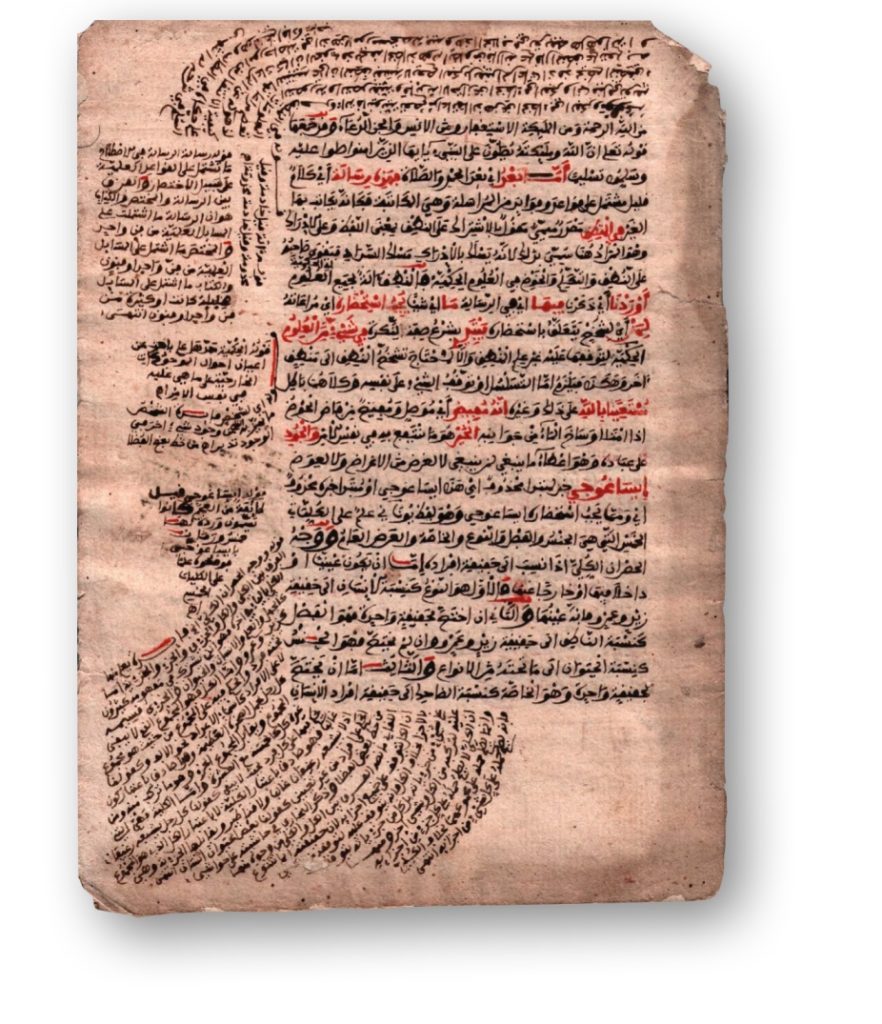
In the foundational sources for jurisprudence (uṣūl al-fiqh) the process of ijtihād is the effort to seek out what the rulings of Sharīʻa are to be (cf. al-Ghazālī, for example). It can be divided into two major parts. The first is textual jurisprudence, which focuses on how rulings are invested with words. In the past, scholars of jurisprudence exerted great efforts in researching the issues of the Text, such as inference, allusion, requirement, the generality and specificity of their application, absolute and qualified application, direction and prohibition, and so on.[1] The second is analogy jurisprudence, since the majority of scholars held that the texts do not meet the society’s needs and the investment of new rulings can therefore be made only by analogical reasoning.
THE SCHOLARS OF THE PRINCIPLES of jurisprudence also made important efforts here to specify what the forms of analogy were and branched out from these forms until this became a long and complex topic, as we see, for example, with al-Āmidi (ob. 631 AH) in his Al-Iḥkām fī Uṣūl al-Aḥkām and Ibn Ḥajar (ob. 636 AH) in Muntahā al-Uṣūl wal-Amal fī ‘Ilmay al-Uṣūl wal-Jadal. Al-Shaṭibī (ob. 790 AH) was distinguished by his book Al-Mawāfaqāt fī Uṣūl al-Sharīʻa with its integrated vision on analogies not founded on analogies that were themselves subsidiary, branching extensions, but by determining these extensions from the general principles and rules. The Ḥanafī jurists opened up a similar method based on establishing major legislative rules, while al-Shaṭibī developed the thought originated by al-Ghazālī (ob. 505 AH). This Ḥanafī method is closest to Roman law and contemporary legislation.
If we take a look at the topics of analogy in the uṣūl al-fiqh works, we find that they relate to three different issues:
The first is the issue of applying the inferral of general expression in the Text to particularised cases. If we were to say, for example, that ‘every intoxicant is forbidden,’ then we have ruled that all kinds of intoxicants that were known in the Arabian Peninsula and that appeared in succeeding ages as prohibited. Ibn Ḥazm al-Ẓāhirī considers that this case is not an example of analogy, because the prohibition is included in the very phrase ‘Every intoxicant is forbidden.’ What the jurisprudents of the various schools therefore labeled ‘analogy’ was nothing other than applying the expression to the possible categories that it may be inferred. And there is much to be said for that opinion.
The second case is one whereby a subsidiary, branch case is applied to another subsidiary case due to the strong commonality between them. An example of this is the analogy attributed to ‘Alī ibn Abī Ṭālib when he was asked about the punishment for drunkenness. He stated:
He who drinks wine is intoxicated, and he who is intoxicated is delusional, and he who is infatuated fabricates lies. The punishment is therefore the same as for the slanderer.
This form of analogy is rejected by the Ẓāhirī school,[2] and their opinion is not devoid of merit since the commonality between two cases is not a permanent constant. We therefore cannot be certain, for example, that everyone who drinks slanders, and any complete matching of the two cases would be exceptional.
The classifications developed by scholars of uṣūl al-fiqh are not religious classifications, even if they are applied to religious texts
The third is the application of a general principle, or universal ruling to a subsidiary, branch case. This type of analogy is known in both ancient and modern legislation, and was rejected by the Ẓāhirī school, while those who defended the analogy replied that without this it was impossible to extract any rulings. This is a logical answer within the limits of the ancient jurisprudential system. The scholars of the uṣūl al-fiqh did not pay the same amount of attention to examining the principles and rules that they paid to the various forms of analogy, since it was the study of these forms that attracted them more.
If we consider this brief sketch of the methodology of legislative thinking, we will see that in the past the scholars of the uṣūl al-fiqh were aware that deriving rulings was no easy matter and that it was not enough simply to adduce a Text in order for the ruling from it to become clear. We would not perhaps be risking too much if we said that the idea of ‘no ijtihād [3] may be made concerning a Text’ was not the brainchild of their ideas, in the sense that it did not mean to them what it means today to some of our contemporaries. They realized that the Text is not self-explanatory and that anyone stepping forward to interpret it must be in a position to distinguish between the general and the specific, the absolute and the qualified, the inferred and the required, and so on.
These investigations are not specific to uṣūl al-fiqh since they are also investigations undertaken in the disciplines of linguistics, rhetoric and literary criticism, and some of them are related to logic. If the Text is to be a source for religion, then the linguistics methodology is a human methodology applied equally to the religious Text and the literary text – in fact to all kinds of text. Mankind employs the same mental processes with respect to a linguistic utterance of any kind.
The classifications developed by scholars of uṣūl al-fiqh are not religious classifications, even if they are applied to religious texts. For the general, the specific, the absolute, the qualified, the inferred and the required – all these are to be found in every text. It is like when we say that a sentence consists of a predicate and a subject. This is a rule that applies to every sentence, whether in a sūra of the Holy Qur’ān, a bawdy poem by Abū Nawās, or an Arabic translation of a text by Karl Marx. What contemporary exponents of the maxim ‘no ijtihād may be made concerning a Text’ fail to understand is that the ancients were formulating mechanisms and theories about the Text that were based on the knowledge of their time. In the modern era, linguistic and semantic sciences have reconsidered many of these issues.
Scholars of uṣūl al-fiqh in the past, as Aristotle before them, failed to pay attention to something important: historicity
Just as the ancients stipulated that anyone dealing with the Text, making commentaries, issuing fatwās, or undertaking ijtihād, should be knowledgeable in the language, and language means linguistic thinking, not merely rules of grammar and morphology. It is therefore logical that contemporaries need to be knowledgeable in issues of modern linguistics and semantics and in what termed the discipline of modern interpretation (ta’wīl) and its various philosophies. No one says that these disciplines are un-Islamic, simply because the interpretative mechanisms are human mechanisms that are not linked to any religion, sect or race. We will see that the investigations on analogy were derived from Aristotelian logic. And when the linguistic sciences declined to become mere dry rules of grammar and morphology to be memorized by heart, any initiatives for ijtihād declined with them, so that and jurisprudence similarly turned into dry rules to be memorized and demonstrated.

Suggested Reading
Moving now to the second section related to analogy and its three issues that we presented, we find that the ancients borrowed from logic to help in defining the forms of analogy, and Muslims saw logic as a science that was common to all nations. Major scholars of uṣūl al-fiqh such as al-Ghazālī and Ibn Ḥazm, worked to prove that the rules of Aristotelian logic existed in the speech of the Arabs too, which meant that logic as a generalised mental mechanisms among humans. When we peruse complex analogical investigations, as appear for example in Ibn al-Ḥajib, we have no doubt that that these were influenced by Islamic commentaries on works of Greek logic and on non-Islamic sources taught, until recently, in Islamic educational institutions – works such as the Isagoge attributed to a Greek logician named Porphyrios and formulated in Arabic by Athīr al-Dīn al-Abharī.
However, scholars of uṣūl al-fiqh in the past, as Aristotle before them, failed to pay attention to something important: historicity. Analogy calls for abstraction, as the analogy of an emergent situation as opposed to an earlier situation requires that the former be extracted and freed from its historically defined context. Such an extraction may be justified if it is made after the original context is clarified. Failing that various pitfalls can occur. While the commentators initiated the category of ‘reasons for the revelations’ in order to provide this clarification of their contexts, the scholars of uṣūl al-fiqh did not come up with anything similar with respect to the subsidiary branches of their analogies, and in the books of uṣūl al-fiqh there are investigations on words and analogical reasoning but no investigations on their historicity or what the ancient classical rhetoricians termed the topos (‘place’). The historicity of ideas and rulings is a concept that was only to develop in the modern era. The classical Islamic sciences, including jurisprudence and uṣūl al-fiqh, are still in need of clarifying their historicity, as well as the historicity of all the opinions and rulings that these sciences contained.
[1] The scholars of jurisprudencecategorised meanings in the Text as ‘explicit’ (‘ibārat al-naṣṣ), ‘alluded to’ (ishārat al-naṣṣ), ‘inferred’ (dalālat al-naṣṣ)[1]or ‘required’ (iqtiḍā’ al-naṣṣ) for reasons of sense. They further divided up the Text into meanings that were absolute (muṭlaq) or qualified (muqayyad), with the rulings based on them accordingly being precise, or limited as to their application. (Ed.)
[2] The short-lived Ẓāhirī legal school insisted on strict adherence to the literal text (ẓāhir) of the Qurʾān and Ḥadīth as the only source of Muslim law. It rejected practices fiqh such as analogical reasoning (qiyās) and pure reason (raʾy) as sources of jurisprudence and looked askance at consensus (ijmāʾ). (Ed.)
[3] ‘Independent legal reasoning’ (see Glossary).
Main image: The إيساغوجي īsāghūjī, Athīr al-Dīn al-Abharī’s translation of Porphyrius’ Εἰσαγωγή (‘Introduction’) to Aristotelian logic, in a North African manuscript dating from the 18th century. The red letters are the original text, the black letters a commentary, and the margins feature a commentary on the commentary.
